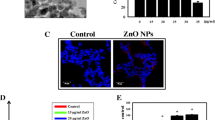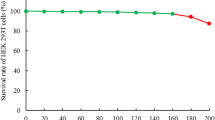Summary
This study investigated the conjoined cellular oxidative damage of human embryo kidney 293T (HEK293T) cells induced by cadmium chloride (CdCl2) and nanometer titanium dioxide (nano-TiO2). RT-PCR technique was used to detect the expressions of Heme oxygenase-1 (HO-1) and 8-oxoguanine DNA glycosylase (OGG1). The activities of superoxide dismutase (SOD) and catalase enzyme (CAT) and concentrations of reactive oxygen species (ROS) and maldondialdehyde (MDA) were measured by different approaches. The results showed that CdCl2 and nano-TiO2 at a low concentration of 0.75 total toxic unit (TU) exerted an additive effects on HO-1 gene expression, CAT activities and MDA concentrations. When the total TU was increased to 1 or 1.25 TU, the interaction was synergetic. Moreover, the mixture with high proportion of CdCl2 produced an additive effect on the OGG1 gene expression, and the interaction was changed to be synergetic when the concentration of CdCl2 was lower than or equal to that of nano-TiO2. Synergetic effects of CdCl2 and nano-TiO2 on cellular oxidative damage of HEK293T cells were found as indicated by the changes in the SOD activities and ROS concentrations. It was concluded that CdCl2 and nano-TiO2 exerts synergistic effects on the cellular oxidative damage of HEK293T cells, and the sensitivity of these indicators of oxidative damage varies with the proportion of CdCl2 and nano-TiO2 in the mixture.
Similar content being viewed by others
References
IARC. Beryllium, cadmium, mercury, and exposures in the glass manufacturing industry. Working Group views and expert opinions, Lyon, 9–16 February 1993. IARC Monogr Eval Carcinog Risks Hum, 1993,58:1–415
Shaikh ZA, Vu TT, Zaman K. Oxidative stress as a mechanism of chronic cadmium-induced hepatotoxicity and renal toxicity and protection by antioxidants. Toxicol Appl Pharmacol, 1999,154(3):256–263
Banfalvi G, Littlefield N, Hass B, et al. Effect of cadmium on the relationship between replicative and repair DNA synthesis in synchronized CHO cells. Eur J Biochem, 2000,267(22):6580–6585
Casalino E, Sblano C, Calzaretti G, et al. Acute cadmium intoxication induces alpha-class glutathione S-transferase protein synthesis and enzyme activity in rat liver. Toxicology, 2006,217(2-3):240–245
Ikediobi CO, Badisa VL, Ayuk-Takem LT, et al. Response of antioxidant enzymes and redox metabolites to cadmium-induced oxidative stress in CRL-1439 normal rat liver cells. Int J Mol Med, 2004,14(1):87–92
Karmakar R, Banerjee A, Datta S, et al. Influence of cadmium intoxication on hepatic lipid peroxidation, glutathione level, and glutathione S-transferase and gamma-glutamyl transpeptidase activities: correlation with chromosome aberrations in bone marrow cells. J Environ Pathol Toxicol Oncol, 1999,18(4):277–287
Koizumi T, Shirakura H, Kumagai H, et al. Mechanism of cadmium-induced cytotoxicity in rat hepatocytes: cadmium-induced active oxygen-related permeability changes of the plasma membrane. Toxicology, 1996,114(2):125–134
Mikhailova MV, Littlefield NA, Hass BS, et al. Cadmium-induced 8-hydroxydeoxyguanosine formation, DNA strand breaks and antioxidant enzyme activities in lymphoblastoid cells. Cancer Lett, 1997,115(2):141–148
Yano CL, Marcondes MC. Cadmium chloride-induced oxidative stress in skeletal muscle cells in vitro. Free Radic Biol Med, 2005,39(10):1378–1384
Lin C, Lin KS. Photocatalytic oxidation of toxic organohalides with TiO2/UV: the effects of humic substances and organic mixtures. Chemosphere, 2007, 66(10): 1872–1877
Quan X, Zhao X, Chen S, et al. Enhancement of p,p′-DDT photodegradation on soil surfaces using TiO2 induced by UV-light. Chemosphere, 2005,60(2):266–273
Gurr JR, Wang AS, Chen CH, et al. Ultrafine titanium dioxide particles in the absence of photoactivation can induce oxidative damage to human bronchial epithelial cells. Toxicology, 2005,213(1–2):66–73
Karlsson HL, Cronholm P, Gustafsson J, et al. Copper oxide nanoparticles are highly toxic: a comparison between metal oxide nanoparticles and carbon nanotubes. Chem Res Toxicol, 2008,21(9):1726–1732
Rahman Q, Lohani M, Dopp E, et al. Evidence that ultrafine titanium dioxide induces micronuclei and apoptosis in Syrian hamster embryo fibroblasts. Environ Health Perspect, 2002,110(8):797–800
Sayes CM, Wahi R, Kurian PA, et al. Correlating nanoscale titania structure with toxicity: a cytotoxicity and inflammatory response study with human dermal fibroblasts and human lung epithelial cells. Toxicol Sci, 2006,92(1):174–185
Wamer WG, Yin JJ, Wei RR. Oxidative damage to nucleic acids photosensitized by titanium dioxide. Free Radic Biol Med, 1997,23(6):851–858
Wang J, Zhou G, Chen C, et al. Acute toxicity and biodistribution of different sized titanium dioxide particles in mice after oral administration. Toxicol Lett, 2007,168(2):176–185
Gallego A, Martin-Gonzalez A, Ortega R, et al. Flow cytometry assessment of cytotoxicity and reactive oxygen species generation by single and binary mixtures of cadmium, zinc and copper on populations of the ciliated protozoan Tetrahymena thermophila. Chemosphere, 2007,68(4):647–661
Bertin G, Averbeck D. Cadmium: cellular effects, modifications of biomolecules, modulation of DNA repair and genotoxic consequences (a review). Biochimie, 2006,88(11):1549–1559
Li N, Sioutas C, Cho A, et al. Ultrafine particulate pollutants induce oxidative stress and mitochondrial damage. Environ Health Perspect, 2003,111(4):455–460
Afaq F, Abidi P, Matin R, et al. Cytotoxicity, pro-oxidant effects and antioxidant depletion in rat lung alveolar macrophages exposed to ultrafine titanium dioxide. J Appl Toxicol, 1998,18(5):307–312
Hussain SM, Hess KL, Gearhart JM, et al. In vitro toxicity of nanoparticles in BRL 3A rat liver cells. Toxicol In Vitro, 2005,19(7):975–983
Jin CY, Zhu BS, Wang XF, et al. Cytotoxicity of titanium dioxide nanoparticles in mouse fibroblast cells. Chem Res Toxicol, 2008,21(9):1871–1877
Long TC, Saleh N, Tilton RD, et al. Titanium dioxide (P25) produces reactive oxygen species in immortalized brain microglia (BV2): implications for nanoparticle neurotoxicity. Environ Sci Technol, 2006,40(14):4346–4352
Long TC, Tajuba J, Sama P, et al. Nanosize titanium dioxide stimulates reactive oxygen species in brain microglia and damages neurons in vitro. Environ Health Perspect, 2007,115(11):1631–1637
Peters K, Unger RE, Kirkpatrick CJ, et al. Effects of nano-scaled particles on endothelial cell function in vitro: studies on viability, proliferation and inflammation. J Mater Sci Mater Med, 2004,15(4):321–325
Chen G, Zhao J, Liu X, et al. Electrochemical sensing DNA damage with nano-titanium dioxide and repair with a medicinal herb species resveratrol. J Biotechnol, 2007,127(4):653–656
Llesuy SF, Tomaro ML. Heme oxygenase and oxidative stress. Evidence of involvement of bilirubin as physiological protector against oxidative damage. Biochim Biophys Acta, 1994,1223(1):9–14
Poss KD, Tonegawa S. Heme oxygenase 1 is required for mammalian iron reutilization. Proc Natl Acad Sci USA, 1997,94(20):10919–10924
Suttner DM, Sridhar K, Lee CS, et al. Protective effects of transient HO-1 overexpression on susceptibility to oxygen toxicity in lung cells. Am J Physiol, 1999,276(3 Pt 1):L443–451
Gabelova A, Valovicova Z, Labaj J, et al. Assessment of oxidative DNA damage formation by organic complex mixtures from airborne particles PM(10). Mutat Res, 2007,620(1-2):135–144
Xia T, Kovochich M, Brant J, et al. Comparison of the abilities of ambient and manufactured nanoparticles to induce cellular toxicity according to an oxidative stress paradigm. Nano Lett, 2006,6(8):1794–1807
Shinmura K, Kasai H, Sasaki A, et al. 8-hydroxyguanine (7,8-dihydro-8-oxoguanine) DNA glycosylase and AP lyase activities of hOGG1 protein and their substrate specificity. Mutat Res, 1997,385(1):75–82
Park EJ, Yi J, Chung KH, et al. Oxidative stress and apoptosis induced by titanium dioxide nanoparticles in cultured BEAS-2B cells. Toxicol Lett, 2008,180(3): 222–229
Author information
Authors and Affiliations
Corresponding author
Additional information
This work was among the National Investigation Projects of Soil Pollution supported by a grant from Ministry of Environmental Protection of the People’s Republic of China.
Rights and permissions
About this article
Cite this article
Xia, B., Chen, J. & Zhou, Y. Cellular oxidative damage of HEK293T cells induced by combination of CdCl2 and Nano-TiO2 . J. Huazhong Univ. Sci. Technol. [Med. Sci.] 31, 290–294 (2011). https://doi.org/10.1007/s11596-011-0369-4
Received:
Published:
Issue Date:
DOI: https://doi.org/10.1007/s11596-011-0369-4




